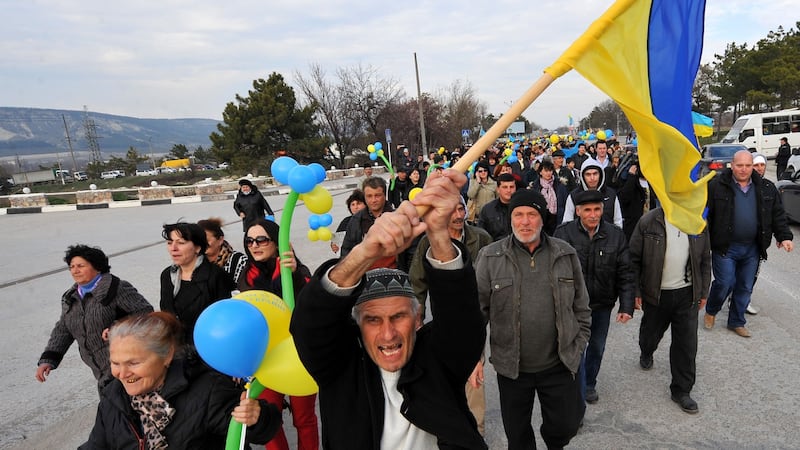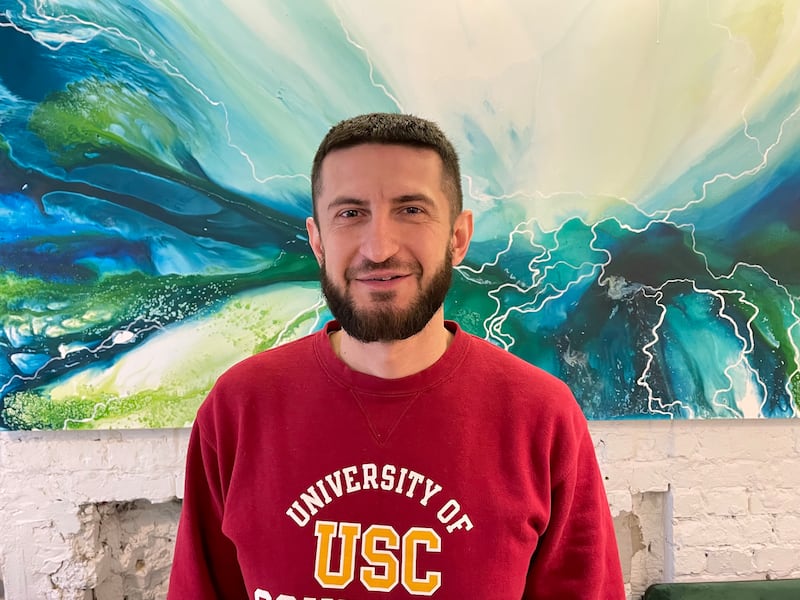As Ukraine prepares to mark two years since the start of Moscow’s full-scale invasion, its Crimean Tatars are recalling the Kremlin’s occupation of their homeland a decade ago, and many are wondering when and how they might return to the Black Sea peninsula.
On February 27th, 2014, heavily armed Russian soldiers wearing no insignia launched operations to seize Crimea’s regional parliament, Ukrainian military bases and other strategic sites while posing as what Moscow called local self-defence volunteers.
It was Russian president Vladimir Putin’s response to the Maidan revolution, which had ended a week earlier in Kyiv with victory for huge reformist, pro-western and anti-corruption protests that had prompted Ukraine’s Kremlin-backed leader Viktor Yanukovich to flee.
He escaped via Crimea into exile in Russia, where the Kremlin and state media portrayed Ukraine’s revolution as a western-backed coup by violent Ukrainian ultra-nationalists who planned to attack Russian speakers in Crimea and the eastern Donbas area.
READ MORE
A Ukraine reeling from the revolution was unable to defend Crimea and ultimately surrendered it with barely a shot, as Russia flooded the region with what it euphemistically called “little green men” – soldiers who oversaw a rigged referendum that the Kremlin used to justify its annexation of the peninsula on March 18th, 2014.
Most of the region’s ethnic Russian majority probably did back annexation, but the declared results were a sham: 97 per cent in favour on supposed turnout of more than 80 per cent, even though the Crimean Tatars and ethnic Ukrainians who made up about a third of the region’s two million population boycotted the vote en masse.

All of Ukraine has suffered since Russia invaded with full force on February 24th, 2022, but the occupation of Crimea a decade ago was particularly painful for its indigenous Muslims.
It came exactly 70 years after the entire Crimean Tatar community on the peninsula was sent into exile by Soviet dictator Joseph Stalin, as collective punishment for supposed collaboration with the Nazis.
About half of the 200,000 exiles died from hunger, thirst, disease and cold on their brutal eastward journey in railway cattle cars and during their first year in remote Central Asia and Siberia.
Crimean Tatars were allowed to return home only in the late 1980s and often faced hostility from settlers in their homeland, many of whom were Soviet servicemen and their relatives.
Isa Akayev (58) was born in exile in Uzbekistan and returned to Crimea in 1989. He moved to Kyiv after the annexation and founded the Krym (Crimea) battalion of volunteer fighters, which is made up mostly of Crimean Tatars and Russian Muslims who oppose Putin.
“I don’t know what (Ukraine’s new leaders) were thinking or what information they had at the time, or who made the decision,” he says of Kyiv’s retreat from Crimea when Russian troops exploited a brief power vacuum following the Maidan revolution.
“I think if we had managed to unite the military, police, SBU (security service) and Crimean Tatars and others who opposed Russia in Crimea, then we could have stopped them,” he adds.
“But it would only have been for a while. Sooner or later, we would have got what we got in February 2022 … It was just a matter of time before Russia tried to take over Crimea.”
Akayev’s Crimea battalion fought Russian-led militants who seized parts of Donbas in 2014, helping to defend the Azov Sea port of Mariupol, and then the engineer and father of 13 children returned to civilian life, while continuing to assist the military as a volunteer.
He says contacts in Ukrainian military intelligence warned him in November 2021 that a full Russian invasion was likely, and asked him to prepare his battalion for action.
“We got about 30-50 people together and started training, so by February we were more or less ready,” he adds, recalling his unit’s role in defending areas west of Kyiv during the first month of the full war, when Russian forces bore down on the capital.
“When we went into liberated villages in Kyiv region they were afraid of us at first – they thought we were ‘Kadyrovtsy’,” Akayev says, referring to infamous Russian Muslim fighters loyal to Ramzan Kadyrov, Kremlin-appointed ruler of Chechnya.
“But when they got over that, their joy at being free was great to see. That feeling was even stronger in Kherson when it was liberated later in 2022. We were there too, and it is close to Crimea, and I said to our guys: ‘Kherson was occupied for just a few months and look at their happiness – imagine how it will be when they welcome us in Crimea.”
International human rights groups say Russia has tried to silence the political voice of Crimean Tatars since annexation, by harassing, arresting and jailing those who oppose Kremlin rule and by portraying them as violent extremists.

“We think about 70,000 Crimean Tatars left Crimea since annexation. The last huge wave was in autumn 2022, when Russia introduced the forced mobilisation of people into its army from temporarily occupied territories of Ukraine,” says Alim Aliyev, deputy director of the Ukrainian Institute in Kyiv.
“We also think Russia has brought about 800,000 people to Crimea – that’s about a third of the entire population,” says Aliyev (35), who was born in Uzbekistan.
“This is ‘settlement colonisation’ and it’s not the first time Russia has changed the population of Crimea like this. Many military people and their families are moving there, as well as business people and pensioners. And Russia is also running state programmes to encourage teachers and doctors to move to Crimea.”
Under the control of an increasingly dictatorial Russia, public resistance in Crimea is now largely limited to small acts of defiance, such as pro-Kyiv graffiti and covert placement of flags, ribbons and stickers in the blue-and-yellow colours of Ukraine.
“We need more teachers, books and courses for Crimean Tatar history and culture in schools,” Aliyev says, noting that major universities in Kyiv and Lviv are launching programmes in Crimean studies and the Crimean Tatar language.
“It’s now a battle for the next generations. If we lose, it will be much harder to go back to Crimea. There is huge Russian propaganda in Crimean schools now, and they are showing Crimean Tatar children new ‘heroes’ from the Russian side – people like Putin. If we don’t have strong culture, then children will be drawn to a culture that seems stronger.”
Kyiv’s forces have been under pressure in eastern Ukraine for several months and abandoned the Donbas town of Avdiivka last week, but western-supplied cruise missiles and Ukrainian-made aerial and marine drones have allowed them to inflict heavy damage on Russia’s Black Sea Fleet in Crimea, much of which has now moved east of the peninsula.
Aliyev says pro-Ukrainian people in the region “get most scared when nothing is happening around Crimea and no one is talking about Crimea. When there are these missile and drone attacks by Ukraine they think, ‘Good, we are waiting for you to come back.’”
Crimean Tatars are among the 100,000 or so Ukrainian refugees that Ireland has taken in since 2022 – Aliyev’s brother lives in Ireland and Akayev calls back after the interview to “thank the Irish people for all they are doing for Ukrainians, and especially for Crimean Tatars”.
Neither man expects to return home soon, or for Russia to leave Crimea without a fight.
“Without the military defeat of Russia, it will not be possible to get Crimea back,” Akayev says. “And it is my deep conviction that if Russia continues to exist in its current borders, then there will be no final victory. The state of Russia as it exists now … should become many smaller national states and then it won’t be a threat to anyone,” he adds.
“Just as the Soviet Union collapsed and stopped being a threat to the world, so the Russian Federation needs to go the same way.”
Aliyev left Crimea in January 2014 – almost a third of his life has been spent in exile, echoing the bitter experience of his ancestors.
“Now we are living a postponed life. I don’t really feel happiness, because I am not in my motherland,” he says.
“I think it will take politics and military action to get Crimea back. But this is a marathon, not a sprint. And we have already been running for 10 years.”
- Sign up for push alerts and have the best news, analysis and comment delivered directly to your phone
- Find The Irish Times on WhatsApp and stay up to date
- Our In The News podcast is now published daily - Find the latest episode here






















